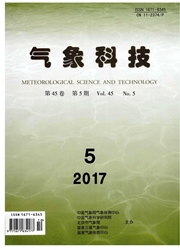

 中文摘要:
中文摘要:
双偏振天气雷达具有改善测雨精度及识别降水粒子相态的能力,但其系统自身有可能会对差分反射率因子(ZDR)的测量精度产生明显的偏差,从而降低气象产品的可靠度。美国利用升级为双偏振的WSR88D进行了大量试验,认为需要校正传输信号在发射和接收通道路径上引起的差异。本文根据其试验报告,以我国研制的车载c波段双偏振多普勒雷达作为试验平台,对比分析后得出产生ZDR系统误差的主要来源为:发射通路、接收通路与天线支路。因此,使用交叉与平行法消除测试信号及设备产生的差异影响,对3部分路径重要节点进行测量并计算出水平、垂直两通道的相对偏差值,进而订正ZDR。其中,天线支路偏差值长期稳定,可相应减少测量次数;发射、接收通路的偏差值会随设备运行产生随机变化,需定期进行测量。以体扫模式最高仰角下的干雪为自然目标物的方法来验证定标的效果,结果表明此方法可较好地订正ZDR的系统误差,为今后偏振雷达业务应用提供了一套消除ZDR系统误差的有效方法。
 英文摘要:
英文摘要:
In contrast to conventional weather radar, the dual polarity weather radar transmits and receives both horizontal and vertical polarized signals, which significantly improves the accuracy of radar-based rainfall measurements and enhances the ability to classify precipitation. However, the measuring results can be affected by the radar system itself. The differential reflectivity ZDR can be estimated imprecisely, resulting in a decreased reliability of generated meteorological products. The National Weather Service made a large number of experiments on upgraded WSR-88D radar and found that it is necessary to straighten the deviation made by signal differences in both transmit and receive paths. After a plenty of experiments on the C-band dual polarity vehicle Doppler radar and comparing the results with United States WSR-88D test reports, it is concluded that that bias of the ZDR calibration consists mostly of 3 components which are transmit bias, receive bias, and sun measurement bias. The biases can be adjusted by using cross and parallel methods to eliminate effects of test signals, cables, and other equipment differences. Furthermore, dry aggregated snow is considered as an optimal weather target for the calibration of ZDR. The results show that the calibration method is an effective and practical way to reduce the system bias of ZDR so to ensure the precision of dual polarization radar system.
 同期刊论文项目
同期刊论文项目
 同项目期刊论文
同项目期刊论文
 期刊信息
期刊信息
